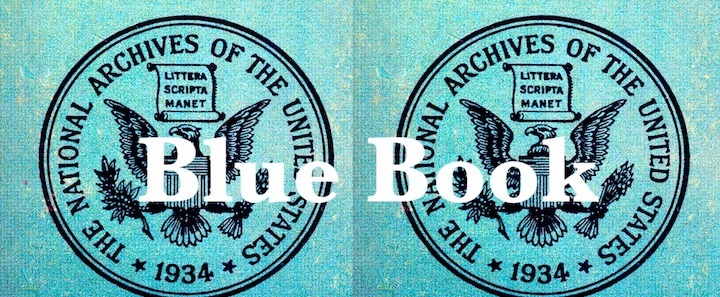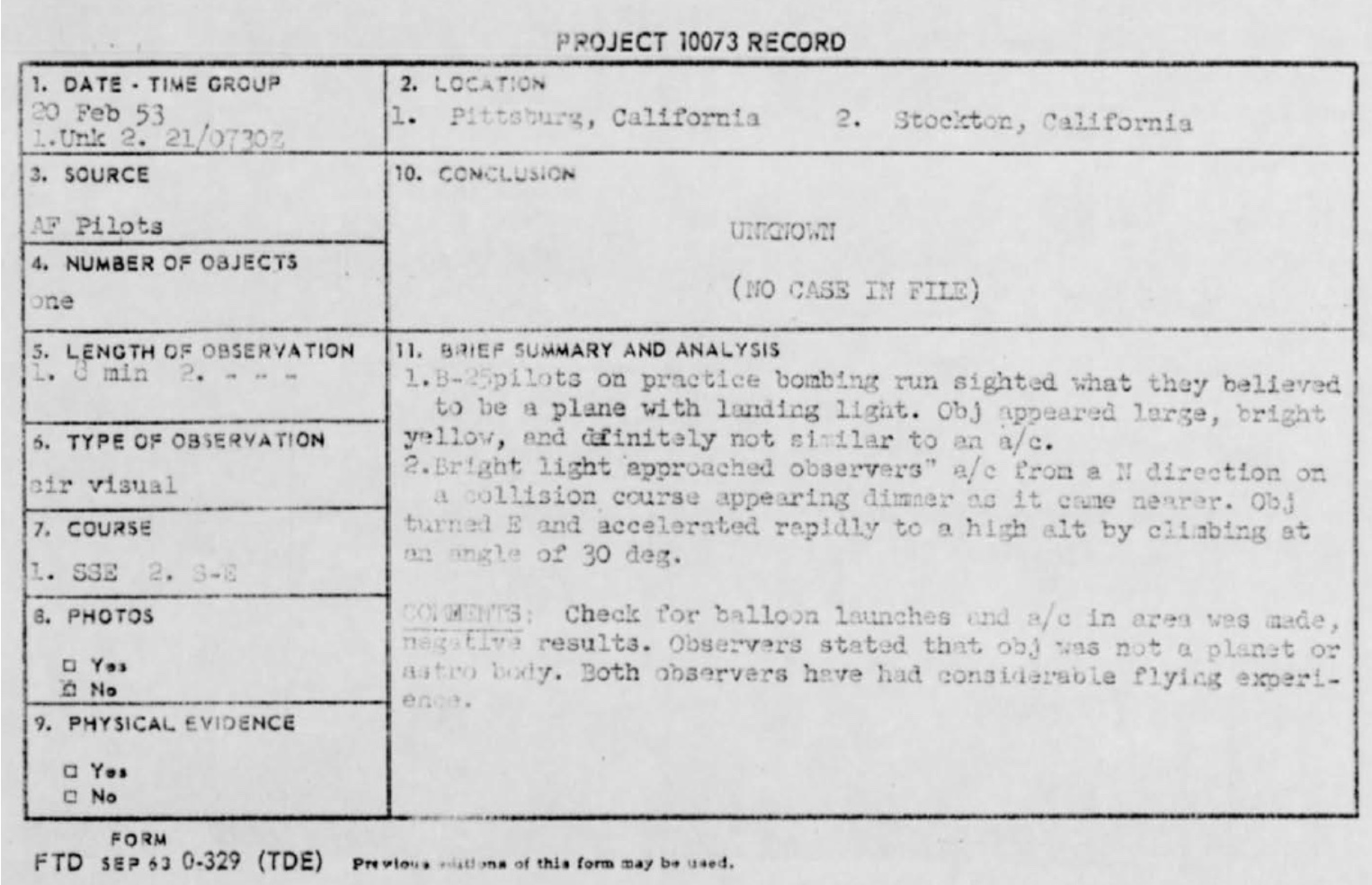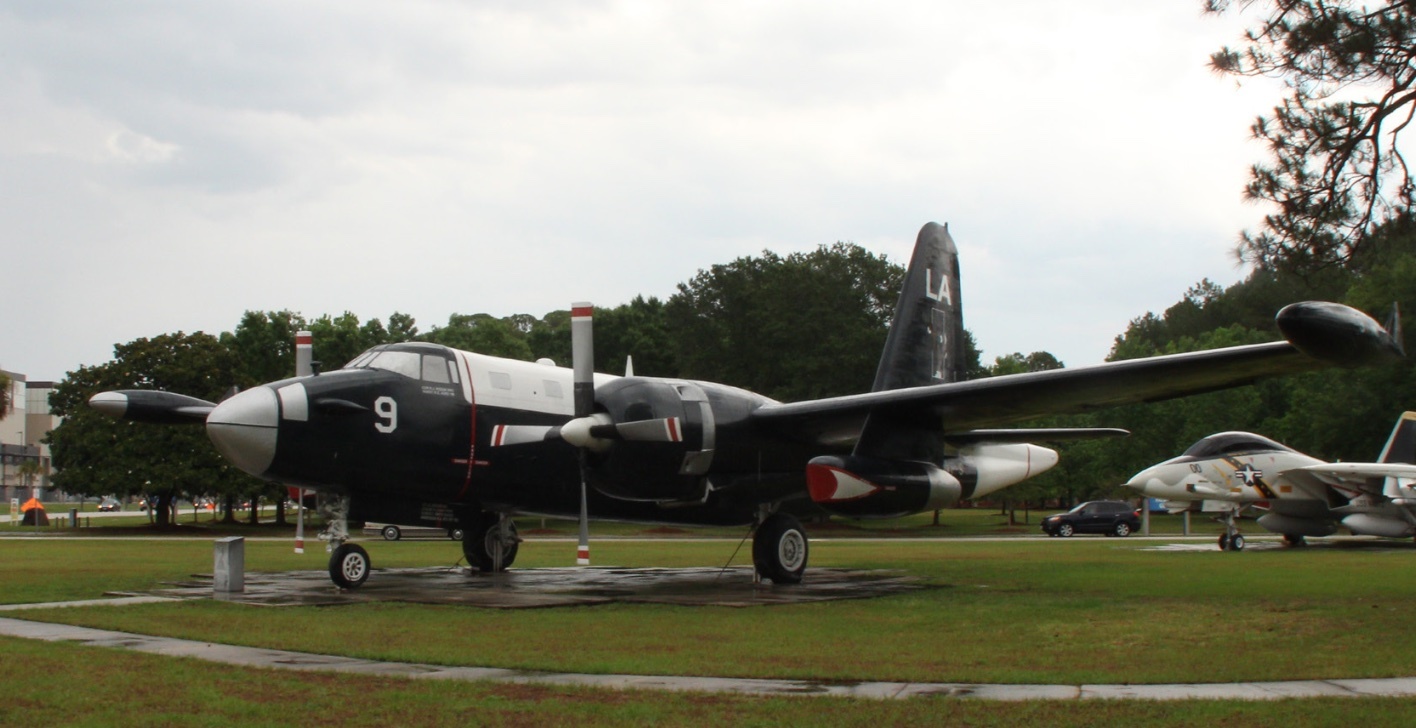
The 701 club: Case 2426: Stockton/Pittsburg, California 20 February 1953
Don Berlinner describes the case as follows:
Feb. 20, 1953; Pittsburg-Stockton, California. #1 time unknown; #2, 10:30 p.m. Witnesses: USAF B-25 bomber pilots. #1 was a bright yellow light seen for 8 minutes. #2 was a bright light which flew on a collision course, dimmed and climbed away fast.1
Sparks’ entry is basically a repeat of Berlinner’s and adds nothing in the way of new information.2 He does question if the time is correct and suggests it was possibly 11:30 PM PST.
The Blue Book file

The case file is almost empty. It consists of a record card and a map. The map is not even related to the sighting and appears to have been from a Korean sighting on the same date. That leaves us with the record card being the sole source of any information.
This is pretty thin on information. To summarize:
-
The first sighting happened near Pittsburg, California while the B-25s were practicing bombing runs. There is no time listed for this sighting and the location of the bombing area was not defined. I doubt they were practicing the bombing runs in Pittsburg.
-
The sighting was to the SSE and consisted of a bright yellow light that was visible for eight minutes. There is no indication of very much movement. It is assumed the light was there and then it turned off.
-
The second sighting apparently happened near Stockton, California at 0730Z (1130 PM PST). I assume this was during the air- craft returning to base.
-
This consisted of another light that came from the north and seemed to be on a collision course with the aircraft. The object dimmed and climbed rapidly upward to the East. The duration of this incident is not listed but, based on the description, it was probably of short duration.
-
It is stated that a search of balloon and aircraft activity was conducted and there were no other aircraft/balloons in the area. It does not say how extensive the search for aircraft activity was by the investigating officer since all we have is the record card. Did he search a radius of 50-100 miles or just the vicinity of the area the aircraft were located?
Analysis
There is not a lot of information to go with here. It is best to address each sighting.
For the first sighting, there is no time listed but one can conclude it was before the time of the second sighting at 0730Z. The cruising speed of a B-25 is about 230mph and the distance between the sightings was about 35 miles. Therefore, this was roughly 10 minutes prior to the second sighting. However, the card indicates it was during practice bombing runs. We can assume that the runs covered a time period of 30-60 minutes. This brings us to a time period of 0620 and 0720Z. For analysis purposes, we can assume the time was about 0700Z.
We first have to check what astronomical objects might be visible at the time of the sighting towards SSE or SE. To the East was Arc- turus and to the ESE, Saturn and Spica were close together. However, to the SSE, there were no astronomical objects of significant magnitude to be of interest. Therefore, what was sighted was not a celestial object.
The next thing to consider are aircraft. According to the record card, this was what the pilots thought they had seen. The card says they checked for aircraft but we don’t know how hard they looked. If it were an aircraft, it would have to have been a landing light and heading towards the direction of Pittsburg. Assuming the SSE direction is correct, we can look to the south and see what air- fields were in that direction.
In that direction were the cities of San Jose, Mountain view, and Freemont, California. This includes Moffett field and San Jose airport at a distance of about 50 miles. Moffett field was operated by the Navy in 1953 and had jet fighter aircraft (mostly F9F pan- thers). They also provided aircraft facilities for patrol aircraft. In 1953, the Navy’s newest patrol aircraft was the P2V.

San Jose’s airport was small in 1953 but it did service aircraft and have airline flights with Southwest airways as a stop between San Francisco and Los Angeles. The last flight in on the 20th was at 9:30 PM (0530Z), which was two hours before the incident.5 Even if there was a delay or the time of the first event was one hour prior to the second, it seems that using this flight to explain the light is a bit of a stretch.
To the Southeast were Tracy and Vernalis. These were small airfields. Vernalis was not very active except for Skyhook balloon launches. The balloon launch on the 20th was around 1608 UTC/PST and “landed” in Arizona about 29 hours later. The launch on the 19th also landed in Arizona. It seems unlikely that either balloon was airborne in the region at the time of the sighting.
There is no positively identifiable aircraft to produce the light. That being said, there are possibilities that may not have been checked. The possibility exists that it may have been a P2V, which carried a large spotlight for surface search missions at night, mak- ing a landing approach to Moffett. The P2Vs did use Moffett field for testing and, at a distance of 50 miles, that spotlight, or even the landing lights, would stand out. Landing lights from aircraft flying out of Manchester airport from my dark sky site in Hillsborough, NH are usually as bright as -1 or -2 magnitude stars. The approximate distance is about 32 miles. I see similar effects from aircraft departing Logan Airport in Boston from Manchester, New Hampshire, which is a distance of 40-50 miles.
The second sighting appears to have the same characteristics of a bright meteor. Pilots have confused meteors as being on a collision course with them over the years. Without a duration, it is not a solid conclusion but the description of rapid acceleration indicates a short duration. The change in direction is probably an error in observation.
Conclusion
This case is challenging to produce a complete explanation because of the lack of data. One can easily classify both cases as in- sufficient information instead of “Unknown”. That being said, one can also suggest that these were possible observations of an aircraft light and a meteor. In my opinion, what information that is available does not eliminate these possibilities. The sighting should be listed as “Possible aircraft/meteor” and removed from the list of unknowns.
Quelle: SUNlite 1/2023
